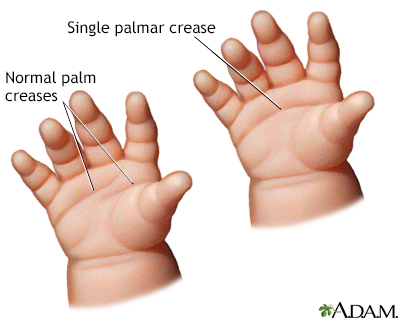Single palmar crease
Transverse palmar crease; Palmar crease; Simian crease
A single palmar crease is a single line that runs across the palm of the hand. People most often have 3 creases in their palms.
The crease is most often referred to as a single palmar crease. The older term "simian crease" is not used much anymore, since it tends to have a negative meaning (the word "simian" refers to a monkey or ape).
Images

Considerations
Distinct lines that form creases appear on the palms of the hands and soles of the feet. The palm has 3 of these creases in most cases. But sometimes, the creases join to form just one.
Palmar creases develop while a baby is growing in the womb, most often by the 12th week of gestation.
A single palmar crease appears in about 1 out of 30 people. Males are twice as likely as females to have this condition. Some single palmar creases may indicate problems with development and be linked with certain disorders.
Causes
Having a single palmar crease is often normal. However, it may also be associated with various conditions that affect a person's mental and physical growth, including:
- Down syndrome
- Aarskog syndrome
- Cohen syndrome
- Fetal alcohol syndrome
- Trisomy 13
- Rubella syndrome
- Turner syndrome
- Klinefelter syndrome
- Pseudohypoparathyroidism
- Cri du chat syndrome
What to Expect at Your Office Visit
An infant with a single palmar crease may have other symptoms and signs that, when taken together, define a specific syndrome or condition. Diagnosis of that condition is based on a family history, medical history, and complete physical exam.
Your health care provider may ask questions such as:
- Is there a family history of Down syndrome or other disorder associated with a single palmar crease?
- Does anyone else in the family have a single palmar crease without other symptoms?
- Did the mother use alcohol while pregnant?
- What other symptoms are present?
Based on the answers to these questions, the medical history, and the results of the physical exam, further testing may be necessary.
Related Information
Gestational ageReferences
Jones KL, Jones MC, del Campo M. Recognizable patterns of malformation. In: Jones KL, Jones MC, del Campo M, eds. Smith's Recognizable Patterns of Human Malformation. 8th ed. Philadelphia, PA: Elsevier; 2022:chap 1.
Knoll J, Forsyth R, Pryor S. Genetics: metabolism and dysmorphology. In: Kleinman K, Mcdaniel L, Molloy M, eds. The Harriet Lane Handbook. 22nd ed. Philadelphia, PA: Elsevier; 2021:chap 13.
Slavotinek AM. Dysmorphology. In: Kliegman RM, St. Geme JW, Blum NJ, Shah SS, Tasker RC, Wilson KM, eds. Nelson Textbook of Pediatrics. 21st ed. Philadelphia, PA: Elsevier; 2020:chap 128.
BACK TO TOPReview Date: 4/25/2023
Reviewed By: Charles I. Schwartz, MD, FAAP, Clinical Assistant Professor of Pediatrics, Perelman School of Medicine at the University of Pennsylvania, General Pediatrician at PennCare for Kids, Phoenixville, PA. Also reviewed by David C. Dugdale, MD, Medical Director, Brenda Conaway, Editorial Director, and the A.D.A.M. Editorial team.

Health Content Provider
06/01/2025
|
A.D.A.M., Inc. is accredited by URAC, for Health Content Provider (www.urac.org). URAC's accreditation program is an independent audit to verify that A.D.A.M. follows rigorous standards of quality and accountability. A.D.A.M. is among the first to achieve this important distinction for online health information and services. Learn more about A.D.A.M.'s editorial policy, editorial process and privacy policy. A.D.A.M. is also a founding member of Hi-Ethics. This site complied with the HONcode standard for trustworthy health information from 1995 to 2022, after which HON (Health On the Net, a not-for-profit organization that promoted transparent and reliable health information online) was discontinued. |
The information provided herein should not be used during any medical emergency or for the diagnosis or treatment of any medical condition. A licensed medical professional should be consulted for diagnosis and treatment of any and all medical conditions. Links to other sites are provided for information only -- they do not constitute endorsements of those other sites. © 1997- 2025 A.D.A.M., a business unit of Ebix, Inc. Any duplication or distribution of the information contained herein is strictly prohibited.
